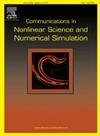Accelerated projection methods for quasimonotone bilevel variational inequality problems with applications
IF 3.8
2区 数学
Q1 MATHEMATICS, APPLIED
Communications in Nonlinear Science and Numerical Simulation
Pub Date : 2025-06-11
DOI:10.1016/j.cnsns.2025.108988
引用次数: 0
Abstract
In this paper, we propose two novel alternated multi-step inertial projection algorithms with self-adaptive step sizes. These algorithms are employed to solve the quasimonotone bilevel variational inequality problem (QBVIP, where VIP denotes a variational inequality problem) with a variational inclusion constraint in a real Hilbert space, where the QBVIP involves a strongly monotone mapping at the upper-level VIP and quasimonotone mapping at the lower-level. We establish the strong convergence of the proposed algorithms under some suitable conditions. Furthermore, we demonstrate the applicability of these algorithms to the split feasibility problem and the generalized Nash equilibrium problem. These works extend and develop some of the existing results in the literature. Finally, we apply our results to LASSO problem and numerical experiments demonstrate the effectiveness and superiority of the proposed algorithms.
拟单调二阶变分不等式问题的加速投影方法及其应用
本文提出了两种具有自适应步长的交替多步惯性投影算法。利用这些算法解决了实数Hilbert空间中具有变分包含约束的拟单调双层变分不等式问题(QBVIP,其中VIP为变分不等式问题),其中QBVIP涉及到上层VIP的强单调映射和下层拟单调映射。在适当的条件下,证明了算法的强收敛性。进一步证明了这些算法对分割可行性问题和广义纳什均衡问题的适用性。这些作品扩展和发展了文献中的一些现有结果。最后,将所得结果应用于LASSO问题,数值实验证明了所提算法的有效性和优越性。
本文章由计算机程序翻译,如有差异,请以英文原文为准。
求助全文
约1分钟内获得全文
求助全文
来源期刊

Communications in Nonlinear Science and Numerical Simulation
MATHEMATICS, APPLIED-MATHEMATICS, INTERDISCIPLINARY APPLICATIONS
CiteScore
6.80
自引率
7.70%
发文量
378
审稿时长
78 days
期刊介绍:
The journal publishes original research findings on experimental observation, mathematical modeling, theoretical analysis and numerical simulation, for more accurate description, better prediction or novel application, of nonlinear phenomena in science and engineering. It offers a venue for researchers to make rapid exchange of ideas and techniques in nonlinear science and complexity.
The submission of manuscripts with cross-disciplinary approaches in nonlinear science and complexity is particularly encouraged.
Topics of interest:
Nonlinear differential or delay equations, Lie group analysis and asymptotic methods, Discontinuous systems, Fractals, Fractional calculus and dynamics, Nonlinear effects in quantum mechanics, Nonlinear stochastic processes, Experimental nonlinear science, Time-series and signal analysis, Computational methods and simulations in nonlinear science and engineering, Control of dynamical systems, Synchronization, Lyapunov analysis, High-dimensional chaos and turbulence, Chaos in Hamiltonian systems, Integrable systems and solitons, Collective behavior in many-body systems, Biological physics and networks, Nonlinear mechanical systems, Complex systems and complexity.
No length limitation for contributions is set, but only concisely written manuscripts are published. Brief papers are published on the basis of Rapid Communications. Discussions of previously published papers are welcome.
 求助内容:
求助内容: 应助结果提醒方式:
应助结果提醒方式:


